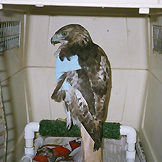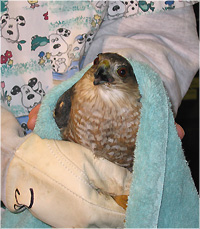'
A bird should be taken to a wildlife rehabilitator if...

-
It is infested with flies, fly eggs or maggots (usually looks like rice or
grain in the bird's feathers or skin)
- Its head is tilted
- It has a drooping or twisted wing
- It is caught or entangled in debris, e.g. string, net, jar, etc.
- It is stuck in a glue trap, or stuck or covered in oil, tar, etc.
- Its eyes are crusty and/or appear unable to see
To safely contain and transport a bird to a wildlife rehabilitator for care,
follow these steps:

-
Prepare a box or other container that can be securely closed. Line the
bottom of the box with a paper towel, t-shirt, or similar so that the bird
can stand without sliding around in the box.
-
Use a towel or blanket to gently throw or drop over the bird, completely
covering its head and wings. Covering the bird’s eyes will help to reduce
stress and keep them calmer during handling. Wearing protective gloves, use
the towel to scoop the bird up while supporting their body, and place them
gently in the prepared transport container. Partially close the container,
then gently pull the capture towel out of the box- do not leave the bird
wrapped in a towel for transport.
-
Ensure the transport container is securely closed to prevent escape. For a
cardboard box, fold the flaps closed and use tape to secure.
-
Keep the animal in a warm, dark, quiet place
that is away from people and pets (a dark closet or bathroom works well).
Resist the temptation to open the box to check on the animal or to take
photos, as this will cause increased stress. Avoid loud noises, talking, and
music.
-
Do not offer food or water, unless instructed to
do so by a permitted wildlife rehabilitator. Improper food given at the
incorrect time can end up making an injured or orphaned animal very sick and
can negatively impact treatment when they arrive at the rehabilitation
center.
-
Bring the bird to your nearest permitted wildlife rehabilitation center as
soon as possible. The sooner the animal receives proper treatment, the
higher the chances that they will be able to be successfully rehabilitated
and return to the wild.
What to do if I have found a bird...
-
That has flown into a window, glass door, or other structure?
Act quickly to contain the bird; follow the above instructions for safe
containment and transport. Place the bird in a warm, dark, and quiet place
and contact a wildlife rehabilitator. Do not offer food or water. Avoid
opening the box to check on the bird as they may attempt to escape and the
additional stress may cause further harm. Do not release the bird, even if
it becomes more alert and active or seems to be unhurt, as it may still
have injuries that are not readily apparent.
-
Inside my house?
Lead the bird to a room that has doors or windows to the outside by
turning off all lights and blocking off all other areas of the house,
except for the path to the desired exit. Open available doors and windows
to the outside, keep people and pets away from the area, and give the bird
some time to make its own way out. Be sure to cover mirrors and close
blinds or hang sheets over unopened windows so the bird does not attempt
to fly into them. Never try to chase a bird out of a building as the
additional stress will make it more likely that the bird will injure
itself in the attempt to escape.
-
Sitting on the ground unable to fly?
-
Spring / Summer: If the bird seems otherwise
normal, hopping around and alert, it is probably a fledgling just
leaving the nest. Fledglings are feathered, and may appear to be
adults, but usually can be distinguished by their shorter tails. If
the bird is in imminent danger (e.g. on the road), carefully move it
to the nearest safe location, preferably under the cover of a bush or
tall grass and within 15 feet of where it was found. Otherwise, do not
handle the bird, as it does not need help. For more information on
fledglings, please see:
https://www.audubon.org/news/when-you-should-and-should-not-rescue-baby-birds
-
Fall / Winter: If an adult wild bird can be
approached or captured, it needs help. Place the bird in a warm, dark,
and quiet box and contact a wildlife rehabilitator. Do not offer food
or water.
-
If you are unsure if a bird is injured or orphaned, observe from a
distance. Take a clear photo and text or email the Wildlife Clinic so
our rehabilitator can help determine if the animal is in need of help.
-
Caught on a glue trap or sticky tape?
Do not attempt to remove the bird from the trap or tape.
Improper removal can cause serious injury or death. Apply tissue or
sprinkle cornmeal, flour, powder, or another dry substance over the
exposed sticky parts of the trap. Place the bird and trap inside of a
closed, dark container. Do not offer food or water. Bring the bird to your
nearest rehabilitator immediately.

|


